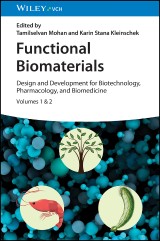Details

Functional Biomaterials
Design and Development for Biotechnology, Pharmacology, and Biomedicine, 2 Volumes1. Aufl.
|
178,99 € |
|
| Verlag: | Wiley-VCH |
| Format: | |
| Veröffentl.: | 09.02.2023 |
| ISBN/EAN: | 9783527827640 |
| Sprache: | englisch |
| Anzahl Seiten: | 608 |
DRM-geschütztes eBook, Sie benötigen z.B. Adobe Digital Editions und eine Adobe ID zum Lesen.
Beschreibungen
<p><b>A succinct handbook explaining interdisciplinary processing, methods, and applications of bio-based materials</b> <p>This book merges the two most important trends in biomaterials: functionalization and renewable chemistry. It covers a variety of biopolymers and various approaches for the transformation of these biopolymers into functional units. Sample topics covered by the two well-qualified authors include: <ul> <li>Fundamental knowledge of biopolymers–natural ones, such as cellulose and other polysaccharides, and synthetic ones, such as polyethylene</li> <li>The origin, classifications, chemical nature, and isolation methods of specific biopolymers</li> <li>The different classical and modern approaches for the transformation of biopolymers into different shapes, ranging from thin films (model surfaces), to nanoparticles, to nanofibers, all the way to 3D scaffolds</li> <li>The morphology, structure, shape, thermal, electrical, and surface properties of biomaterials</li></ul><p>This all-inclusive reference guide, which covers fundamentals, methods, and applications alike, is a key resource for both students and practicing scientists involved in programs of study or disciplines that intersect with the field of biomaterials.
PART I DEFINITIONS, SOURCES, STRUCTURE AND PROPERTIES OF BIOPOLYMERS AND BIOMATERIALS<br> <br> Chapter 1: Definitions, types of biopolymers and biomaterials<br> Chapter 2: Biopolymers and their derivatives introduction, chemical, functional and structural classification<br> Chapter 3: Biopolymer isolation and preparation<br> Chapter 4: Biopolymer supramolecular structure and functions<br> <br> <br> PART II CHARACTERIZATION OF BIOMATERIALS<br> <br> Chapter 5: Methods for characterization of morphological properties of biomaterials<br> Chapter 6: Methods for characterization of structural properties of biomaterials<br> Chapter 7: Methods for analysing the chemical composition of biomaterials<br> Chapter 8: Methods for characterization of dielectric and thermal properties of biomaterials<br> Chapter 9: Methods for characterization of surface properties and solid-liquid interaction studies of biomaterials<br> Chapter 10: Methods for analysing the biological and biomedical properties of biomaterials<br> <br> <br> PART III BIOPOLYMER ULTRATHIN (TWO-DIMENSIONAL) FILMS<br> <br> Chapter 10: Biopolymer ultrathin films: recent trends and challenges<br> Chapter 11: Biopolymer-based flat thin films preparation, characterization and application<br> Chapter 12: Structuring and characterization of biopolymer-based thin films<br> Chapter 13: Application of biopolymer thin films in biomedical applications<br> a. In drug-delivery<br> b. Cell growth<br> c. Biological macromolecule (e.g. proteins, DNA, antibody) interactions<br> <br> <br> PART IV BIOPOLYMER-BASED NANOMATERIALS: CHALLENGES IN PREPARATION, CHARACTERIZATION AND APPLICATIONS<br> <br> Chapter 14: Current synthesis methods, characterization and application of cellulose nanocrystals<br> Chapter 15: Preparation, characterization and biomedical application of Nano fibrillated cellulose<br> Chapter 16: Polysaccharide-based nanofibers synthesis, characterization and application in tissue engineering and regenerative medicine<br> Chapter 17: Polysaccharide nanoparticles different methods of synthesis and their interaction with cells and tissues<br> <br> PART V POLYSACCHARIDE-BASED SCAFFOLDS: DESIGN, FABRICATION AND APPLICATION<br> <br> Chapter 18: Methods and challenges in the preparation of scaffolds for tissue engineering application<br> Chapter 19: Solvent-casting approach for design of scaffold and their potential application<br> Chapter 20: Freeze-dried aerogel/foams for tissue engineering application<br> Chapter 21: Design and characterization of electro spun scaffolds for biomedical application<br> Chapter 22: Polysaccharide-beads preparation, characterization and application in tissue engineering<br> Chapter 23: recent advances in 3d printing in the design and application of cellulose-based polysaccharide scaffolds<br> a. In skin tissue engineering<br> b. In vascular tissue engineering<br> c. In bone tissue engineering<br> d. In cartilage tissue engineering<br>
<p>Assist. Prof. Tamilselvan Mohan obtained his Master of Science in Chemistry in 2006 from the Kanchi Mamunivar Centre for Post Graduate Studies (KMCPGS), Pondicherry, India. Since July 2017, has has been in the group of Prof. Stana Kleinschek, University of Maribor, where he focuses mainly on the development of various types of functional materials for flame-retardant, paper conservation and tissue engineering applications. <p>Prof. Karin Stana Kleinschek obtained her PhD degree from the Institute of Physical Chemistry of the University of Graz, Austria. Her field of expertise is surface modification and characterization of polysaccharides and its usability in biomedical applications. She works as Full Professor at the Faculty of Mechanical Engineering of the University of Maribor (UM), where she teaches various courses on Polymer Chemistry, Surface Characterization of Polymeric Materials and Textile Chemistry.

















